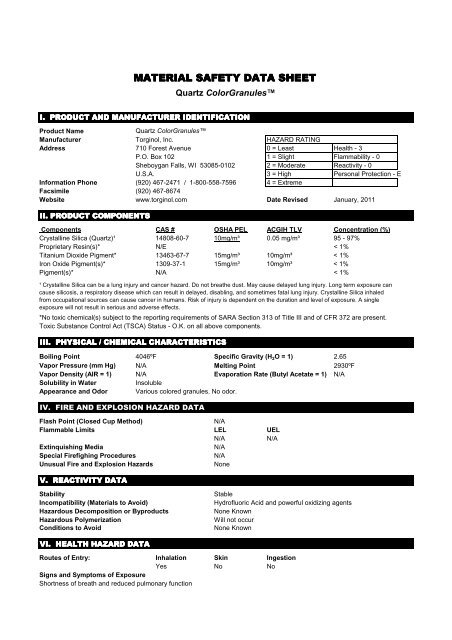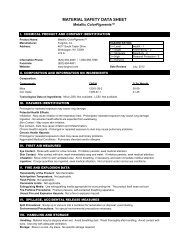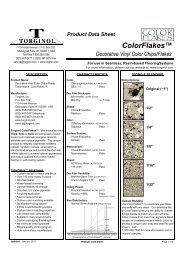Torginol - ColorGranules - MSDS (2011)
Torginol - ColorGranules - MSDS (2011)
Torginol - ColorGranules - MSDS (2011)
Create successful ePaper yourself
Turn your PDF publications into a flip-book with our unique Google optimized e-Paper software.
MATERIAL SAFETY DATA SHEETQuartz <strong>ColorGranules</strong>I. PRODUCT AND MANUFACTURER IDENTIFICATIONProduct NameQuartz <strong>ColorGranules</strong>Manufacturer<strong>Torginol</strong>, Inc.HAZARD RATINGAddress 710 Forest Avenue 0 = Least Health - 3P.O. Box 102 1 = Slight Flammability - 0Sheboygan Falls, WI 53085-0102 2 = Moderate Reactivity - 0U.S.A. 3 = High Personal Protection - EInformation Phone (920) 467-2471 / 1-800-558-7596 4 = ExtremeFacsimile (920) 467-8674Website www.torginol.com Date Revised January, <strong>2011</strong>II. PRODUCT COMPONENTSComponents CAS # OSHA PEL ACGIH TLV Concentration (%)Crystalline Silica (Quartz)¹ 14808-60-7 10mg/m³ 0.05 mg/m³ 95 - 97%Proprietary Resin(s)* N/E < 1%Titanium Dioxide Pigment* 13463-67-7 15mg/m³ 10mg/m³ < 1%Iron Oxide Pigment(s)* 1309-37-1 15mg/m³ 10mg/m³ < 1%Pigment(s)* N/A < 1%¹ Crystalline Silica can be a lung injury and cancer hazard. Do not breathe dust. May cause delayed lung injury. Long term exposure cancause silicosis, a respiratory disease which can result in delayed, disabling, and sometimes fatal lung injury. Crystalline Silica inhaledfrom occupational sources can cause cancer in humans. Risk of injury is dependent on the duration and level of exposure. A singleexposure will not result in serious and adverse effects.*No toxic chemical(s) subject to the reporting requirements of SARA Section 313 of Title III and of CFR 372 are present.Toxic Substance Control Act (TSCA) Status - O.K. on all above components.III. PHYSICAL / CHEMICAL CHARACTERISTICSBoiling Point 4046ºF Specific Gravity (H 2 O = 1) 2.65Vapor Pressure (mm Hg) N/A Melting Point 2930ºFVapor Density (AIR = 1) N/A Evaporation Rate (Butyl Acetate = 1) N/ASolubility in WaterInsolubleAppearance and Odor Various colored granules. No odor.IV. FIRE AND EXPLOSION HAZARD DATAFlash Point (Closed Cup Method)N/AFlammable Limits LEL UELN/AN/AExtinquishing MediaN/ASpecial Firefighing ProceduresN/AUnusual Fire and Explosion HazardsNoneV. REACTIVITY DATAStabilityIncompatibility (Materials to Avoid)Hazardous Decomposition or ByproductsHazardous PolymerizationConditions to AvoidStableHydrofluoric Acid and powerful oxidizing agentsNone KnownWill not occurNone KnownVI. HEALTH HAZARD DATARoutes of Entry: Inhalation Skin IngestionYes No NoSigns and Symptoms of ExposureShortness of breath and reduced pulmonary function
VI. HEALTH HAZARD DATA (CONTINUED)Routes of Entry: Inhalation Skin IngestionYes No NoSigns and Symptoms of ExposureShortness of breath and reduced pulmonary functionHealth Hazards (Acute and Chronic)Acute Effects: Irritation of skin and dermatitisChronic Effects: Excessive inhalation of dust may result in respiratory disease such as silicosis, pulmonaryfibrosis, etc.The IARC has evaluated in vol. 42 (monographs) that there is "sufficient evidence for the carcinogenicity ofcrystalline silica dust to experimental animals" and "limited evidence" with respect to humans.Carcinogenicity: NPT? IARC Monographs? OSHA Regulated?Yes (Respirable Silica) Yes* Level 2A Grouping NoMedical Conditions Generally Aggravated by ExposureLung disorders and persons subject to eye irritation.Emergency and First Aid ProceduresEYES - Flush with water, holding lids open for 15 minutes or more. Call physician for advice if necessary.SKIN - PROMPTLY wash with soap and water. DO NOT wash with solvents. Seek medical attention ifirritation develops or persists.INHALATION - Move person to fresh area if effects occur. If needed, give oxygen or artificial respiration toimprove breathing. Consult physician.INGESTION - Expected to be slightly toxic by ingestion. If swallowed, induce vomiting immediately asdirected by a physician. Get medical attention immediately. Never give liquids to an unconscious orconvulsing person.OTHER HEALTH EFFECTS - Medical conditions which may be aggravated by exposure to the product includeconjunctivitis of the eye, dermatitis of the skin, asthma and respiratory diseases. Sensitization may occurby skin contact.NOTE: Persons with lung disorders or who are sensitized should not use this product.VII. CONTROL MEASURESRespiratory Protection (Specify Type)"Provide adequate exhaust ventilation; usa a NIOSH - approved respirator if PELS/TLVS are exceeded"VentilationLocal Exhaust - to meet PEL requirementsMechanical - Adequate to meet PEL requirementsSpecial - None KnownProtective Gloves - RecommendedEye Protection - RecommendedOther PrecautionsUse adequate ventilation and dust collection. To minimize exposure, wear a respirator approved for silica dustwhen using, handling, storing or disposing of this product. Refer to the most recent standards of ANSI(Z88.2), OSHA (29 CFR 1910.134) MHSA (30 CFR Parts 56 and 57), and NIOSH Respirator Decision Logic.Maintain, clean and fit test respirators in accordance with OSHA RegulationsVIII. PRECAUTIONS FOR SAFE HANDLING AND USESteps to be Taken in Case Material is Released or SpilledDo not breathe dust. Do not rely on your sight to determine if dust is in the air. Silica may be in the airwithout a visible dust cloud. Avoid creation of respirable dust.Waste Disposal MethodDispose waste material in a sanitary land fill or as regulated by local, state and federal regulations.Precautions to be Taken in Handling and StoringAvoid creation of respirable dust. Take precaution against bag breakage.IX. DISCLAIMERDisclaimerThe information contained herein is based on the data available to us and is believed to be correct.<strong>Torginol</strong>, Inc. makes no warranty expressed or implied regarding the accuracy of this data or the resultsto be obtained from the use thereof. Torignol, Inc. assumes no reponsibility for injury, loss or damagefrom the use of the product described.






